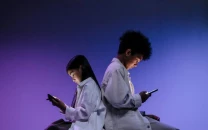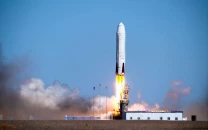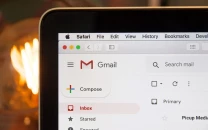Huawei’s $2,800 Mate launch sparks frustration over supply issues
Eager buyers in China were met with frustration as only pre-order customers could purchase the new phone
1726827102-0/BeFunk_§_-(18)1726827102-0-640x480.webp)
Huawei's much-anticipated $2,800 tri-foldable smartphone, the Mate XT, hit the market on Friday, but many fans were left disappointed due to limited stock availability.
Eager buyers in China, particularly in Shenzhen and Beijing, were met with frustration as only pre-order customers could purchase the new phone, leaving walk-in customers empty-handed.
At Huawei’s flagship store in Shenzhen, fans expressed dismay after being informed that only confirmed pre-orders were eligible to purchase the Mate XT.
One university student, surnamed Ye, who had been queuing since 10 p.m. the previous night, said, "They should have made it clear we can’t buy." Similar sentiments were echoed in Beijing, where dozens of consumers, including manufacturing worker Guo, were disappointed after spending hours waiting to purchase the phone.
The tri-foldable Mate XT, which folds three ways like an accordion, has been generating significant interest since its unveiling earlier this month, with pre-orders exceeding 6.5 million.
However, analysts had warned that supply chain constraints could hamper the availability of the innovative device. Huawei did not disclose how many units had been produced for the launch, or how many customers would receive their phones on launch day.
Despite the widespread excitement surrounding the Mate XT, many fans were disappointed by the company's inability to meet demand.
Analysts attribute the shortages to production issues, especially concerning key components like the phone’s display panel, cover glass, and hinges.
Lori Chang, a senior analyst with Isaiah Research, highlighted that production yield issues could be delaying the phone’s mass rollout.
With a price tag of $2,800, the Mate XT is more than twice as expensive as Apple’s iPhone 16 Pro Max, which starts at $1,199.
Despite the hefty price, pre-orders for the Mate XT have nearly doubled the 3.9 million foldable smartphones shipped worldwide in the second quarter of 2024, according to IDC.
Amber Liu, an analyst at Canalys, said that while the Mate XT represents a significant technological leap, it may struggle to replicate the sales volume of its bi-folding predecessor, the Mate X5.
The Mate XT’s launch highlights Huawei’s ability to innovate despite ongoing US sanctions, which have restricted its access to certain technologies.
The company has increasingly relied on locally sourced components, including in its Pura 70 series, which underscores its push for tech self-sufficiency.
However, Huawei’s struggles with supply chain issues demonstrate the lingering impact of the sanctions on its ability to meet demand.
Huawei's executive director, Richard Yu, stated that Mate XT sales had exceeded expectations and assured that the company was working to expand production capacity.
However, no details were provided on how soon these supply issues would be resolved.
Huawei’s Mate XT launch coincided with Apple’s release of the iPhone 16 in China, setting the stage for a competitive showdown in the world's largest smartphone market. While Huawei’s tri-foldable phone has captured attention, Apple’s new devices face their own challenges.
One of the major concerns is Apple’s lack of an AI partner in China, delaying the rollout of its AI-powered features until next year. Some Apple users, however, seemed unfazed by this delay, with one customer, surnamed Shi, calling AI a "gimmick" at this stage.
Despite high demand and strong pre-orders for the Mate XT, Huawei’s ability to keep up with production remains in question, potentially limiting the impact of its bold new product in the premium smartphone market.



















COMMENTS
Comments are moderated and generally will be posted if they are on-topic and not abusive.
For more information, please see our Comments FAQ